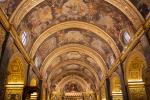Baroque / Rococo
The Baroque is a cultural movement in European art history that had its origins in Rome around 1600. Its appeal turned consciously from the witty intellectual qualities of Mannerist art of the 16th century, and substituted visceral appeal directly to the senses. It employed iconography that was direct, simple, obvious, theatrical, rather than the arcane programs, often worked up by bookish humanists and patrons rather than by the artists themselves, which were characteristic of the urbane coterie arts of mannerism. Baroque art drew on certain broad and heroic tendencies in Annibale Caracci and his circle, and found inspiration in other artists like Correggio and Caravaggio, nowadays sometimes termed 'proto-Baroque'. Germinal ideas of the Baroque can be found in Michelangelo.
Art historians, often Protestant ones, have traditionally emphasized that the Baroque period falls in a time in which the Roman Catholic Church had to react against the many revolutionary cultural movements that produced a new science and new forms of religion (Reformation).It has been said that the monumental Baroque is a style that could give the Papacy, like secular absolute monarchies, a formal imposing way of expression that could restore its prestige, at the point of becoming somehow symbolic of the Counter-Reformation. Effectively, it was successfully developed in Rome, where Baroque architecture widely renewed the central areas with perhaps the most important urbanistic addition (or, more properly, revision). But many other examples are found in other European towns (and in the Spanish Americas). [Source: Wikipedia]































































































































































































































































